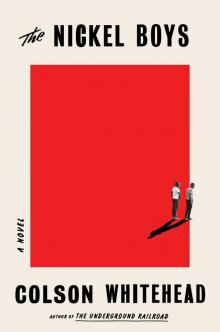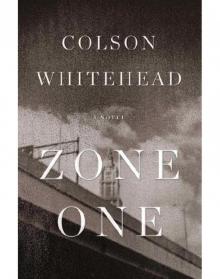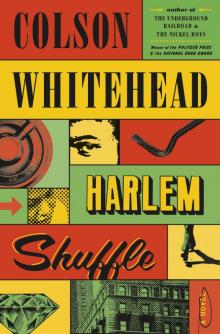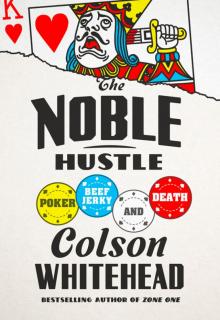- Home
- Colson Whitehead
Sag Harbor Page 9
Sag Harbor Read online
Page 9
The smell, however, was no hypothetical. I made a suggestion. I'd get rid of the maggots, but Reggie would scrub it clean. Motion passed. Afterward, I opened the windows. We didn't yell at each other that much anymore, those days.
Episodes such as these, when even Stephen was put to the test, made us run to the safety of our parents' queen-sized. When you got the big bed, you had it until our parents returned, which meant that when they skipped the weekend, you had it for like eleven days straight. Bonus.
Reggie stuck his head in the door. “There's a blackout,” he said. I got up to check it out. The power went out a lot. Any big storm knocked down a power line or two somewhere across the Long Island grid. Sometimes it was our neck of the woods, sometimes it wasn't. The power went out for a couple of hours, or, in the case of hurricanes, days. Our stove was electric, and we needed electricity for the hot-water heater, but the power usually returned quickly so blackouts were rarely more than a minor nuisance. You broke out the candles, cursed yourself for not buying more batteries after the last blackout even though it had occurred to you plenty of times, and went to bed. By the time you got up in the morning the lights were back on. Usually.
It was beautiful and blue outside. But nothing turned on as I toured the house, flipping, switching, opening the refrigerator. I slipped out the side door to see if I could hear Chuck Woolery's voice booming from Mrs. Johnson's TV—she was a big Love Connection fan and from all evidence had discovered a twenty-four-hour Love Connection channel—and saw the ticket noosed on the doorknob. LILCO had cut off the juice for nonpayment. There was no blackout. It was just us.
“Dag,” Reggie said.
“That's cold, right?” I said.
Reggie went to catch the bus to his job at Burger King and I called our mother at work. “Any message?” her secretary asked. I told her no. Telling my mother's secretary that the juice was shut off, that was impossible. I was wired not to let other people know our business. What happened in the house stayed in the house, caroming off the walls and furniture and us, until it was absorbed or forgotten. When my mother called back, she seemed unconcerned. “That's just a payment mix-up,” she said. “I'll take care of it.” She told us they'd be out on Friday. She'd see us then.
AT A QUARTER TO FOUR, I headed off to work. I sniffed my shirt again: funky. Martine was going to be there to oversee the weekend delivery, and NP was on duty, so I was going to get ribbed over the Head-Patting Incident. Plus, on Thursdays people got an early start on the weekend, dribbling in with their crumpled bills and thirsty stares. It was going to be a tough shift.
The wind had picked up. Maybe it was going to rain, but not anytime soon. I could take the beach shortcut. Taking the beach meant you skipped a bunch of streets, Terry Drive and the rest, emerging on Bay Street with a nice head start. Terry Drive was named after Maude Terry, the spiritual architect of the developments, and, if one followed the long stream of cause and effect, the series of consequences rippling across the generations, responsible for every second of my Sag Harbor life. On old Maude Terry's shoulders lay the blame for all of it.
She was part of a group from Brooklyn and Queens who started coming out in the '30s and '40s, staying in the Eastville section, near the Hempstead House. Eastville was where the black and Indian workers settled during Sag Harbor's whaling boom, working the ships. One day our Maude, after walking through the dirt paths summer after summer to what would become Azurest Beach, decided to investigate who actually owned those woods. Which meant that she had already conceived of some idea of the developments, right? Why investigate unless you had a plan. What incident put the idea in her head, what kind of day or evening did she have to make her hope and scheme, think up such a thing? That was one story not handed down.
The twenty acres belonged to a man named Mr. Gale, who'd been trying to unload them for some time. No one wanted the parcel. It wasn't on the Atlantic, like the prime acreage of Bridgehampton, South Hampton, etc. Terry hatched a plan where she'd sell the lots for him—to her friends, to her friends' friends, and so on, the middle-class black folk of their acquaintance—$750 for an inside lot, $1,000 for a beachfront lot. The word went out. One by one the houses went up.
Cut to forty years later, to me, more specifically, as I made my way to work and confronted one small hitch. Taking the beach shortcut meant running a gauntlet of forced social interaction. That afternoon, I saw as I walked along the side of the house down to the bulkhead, I caught a break. There was only one of my mom's friends on the beach in front of our house. It was Mrs. Collins, Marcus's mother, a copy of People magazine in her lap. Her hand dangled over the side of her beach chair, falling on the rim of her glass of white wine. Sand clumped to the condensation on the glass like rust. There were three empty beach chairs. I saw bathing caps in the water. Good timing.
“How are you today, Mrs. Collins?”
She looked at me over the rim of her sunglasses. “Fine, fine,” she said. She inspected my dirty shirt. “You headed off to that Jonni Waffle?”
“Yes.”
“You going to bring back a little of that Rocky Road?” she asked, as she did every time she caught me on my way to work. I was such a square that I always took her literally, and my mind reeled into desperate scenarios where I was forced to smuggle out a pint under and between laser beams, past infrared sensors. Martine allowed us one take-home pint a week “for our families,” and the mothers of Jonni Waffle employees gleefully spread the word, lording over their access to Candy Apple Praline and Vanilla Nut Swirl. Mrs. Collins and I were not related. If I brought a pint home for a family friend, was I breaking Martine's trust? Did I care about Martine's trust after the Incident? Contributing to my neurotic back and forth was that we didn't carry Rocky Road, that flavor being too pedestrian for the full-tilt exotic cavalcade that was Jonni Waffle. Not only was she asking me to steal; she was asking me to steal something that didn't even exist. A thought problem: the Moron's Dilemma.
To repeat: “You going to bring back a little of that Rocky Road?”
I nodded.
“When are your parents coming out?”
“Tomorrow,” I said.
She smiled. It was a merry joke, when our parents were coming out. “Alright then,” she said.
I went on my way. Most of the houses on the beach back then were modest bungalows, fronted by decks that stabbed out toward the bay or by sloping grass lawns that slunk down to the bulkhead. The exception was the Martins', which squatted over three lots and was a real Hamptons-style modern beach house, one you might see in a magazine when they ran out of white Hamptons houses to feature. Which was never. It was the biggest house in Azurest at that time, a refugee from the other side of the island, its great windows pretending to overlook some tonier stretch of beach. Mr. Martin owned a few R&B stations in the Northeast and was pretty loaded. There were always pickup trucks parked outside belonging to the gardeners, the pool guys, the dudes performing who knew what upgrades and installations inside. I'd never been inside—everyone's parents went to the parties, but kids weren't allowed.
Everyone still talked about Mr. Martin's fiftieth birthday party, when he hired Gladys Knight and a Pip to perform. They could only afford one Pip after all the food and liquor. It was a new breed of bash. Bobby's grandfather, who was part of the first generation, used to tell us how when the houses first started going up, on the dirt roads before the developments got paved, everyone was welcome when you threw a party. Maybe you didn't know each other personally, but you all had the same story, right, when it came down to it: after a long journey you had found safety on this shore. Survivors and neighbors. Weekdays were quiet, run by the wives, who took care of the kids, hit the beach, and tended to the developments with matriarchal care. The men came out on Friday, and the socializing began. If you saw the lights or heard the music, according to Bobby's grandfather, you walked on up and pushed in the screen door, whether you knew the person or not. And once you walked in, you were blood brothers.
/> That sounded crazy, frankly. The custom of a better time. Half the fun of having a party, it seemed—and I speak as someone who was not invited to parties, and thus had an outsider's perspective—was in excluding people, especially your neighbors, who would be forced to listen to the music and laughter, closing their windows to keep noise out as some closed windows to keep noise in.
The houses ended at Azurest Beach proper, where you set up your blankets and gear if you weren't hanging out in front of the house of someone who lived on the beach. It was where Reggie and I and Marcus and Bobby had spent most of our sunny afternoons as children, doing the standard kid-on-a-beach stuff, making things out of sand, throwing dead crabs at one another. Our replacements were there, reenacting our botched creations, our futile pastimes. And one day they'd be passing their own replacements as they tromped off to work in town. I didn't recognize any of their mothers, but waved anyway, and they waved back. We were neighbors.
I jumped over the tiny trickle we had always referred to as the Minnow, but what anyone with any sense called the Drain Pipe, which was less romantic but more honest. It was where the street runoff trickled into the sea. Tiny silver minnows hung out there, which we used to use for bait. We dragged an old bedspread up toward the ridged pipe, scooping up dozens of fish into our dingy net. When we hoisted the cloth between us, straining against the weight of the water as it drained out, the minnows hopped and flopped on the dirty threads. We drove our hooks through them, twisting their slender bodies on the metal as their guts and eyes popped out. We dropped our lines off the Long Wharf or dry-cast off Azurest, hoping for a nibble from the porgies and baby snappers. We hadn't fished in years.
The Minnow meant that I'd reached the Public Beach, another neglected haunt, although this was to change next year when we started getting high in the parking lot, in Bobby's car. The Public Beach—which was open to all of Sag Harbor, i.e., the white people—was now key in that it provided the second half of the shortcut to town, to work. The commute to Jonni Waffle, indeed everything Jonni Waffle–related, occupied such prime real estate in my brain that I had even stopped having swimming-lesson flashbacks when I got to the Public Beach. Quite a feat, given the tormenting echoes of my failure and their reverberations through the years. The ghostly phrases—“Blow out your nose!,” “Now float!,” “Let go of my arm, goddamnit!”—were just a whisper, barely audible over the tide. Swimming Instructor, Prison Camp Guard. It was my first lesson in true uselessness. Guppy, Snapper, Shark—I can't remember the specific benchmarks because I never reached them. I was left back three years in a row, the tallest Guppy on the beach, looming over the little kids like a gawky monument to ineptitude, whereupon my mother washed her hands of me. A Sag Harbor Baby was someone who had been coming out here since birth, like my mother, like Reggie and me, like those kids I had just passed on Azurest Beach. A Sag Harbor Baby who couldn't swim was a shame on the whole community, a deficiency in that area being a widely recognized predictor of later deviancy Red Tompkins, for example, was a notorious nonswimmer, and we all know how he ended up despite all the advantages. Glug glug.
I walked through the parking lot and up the road, splitting off to hit the last leg of the shortcut, a shunt of woods that let out on Bay Street. There's a house there nowadays, so you have to take the long way around. I've retraced my old routes to make sure what I know is plausible in the retelling, and to give a sporting chance to the Forgotten and the Repressed, those two overlooked cousins of ours there in the corner avoiding eye contact. (Chime in whenever, guys.) The house is cool, stark-angled, a gray gargoyle of hip, and I like it even though it doesn't fit in with the rest of the houses on Bay Street, the Dutch colonials with long capacious porches, the Gothic revival abodes, inevitably festooned with red-white-and-blue bunting come July Fourth. The last time I visited, the new house had a plastic playground set in the yard, which seemed odd, because the public beach's playground was so close. But then kids don't play out there like we used to.
The shortcut slingshotted us into White Sag Harbor and had the bonus of zipping us past the house on the corner of Bay and Hemp-stead, where a pack of dogs, pampered Labs and well-brushed spaniels, always burst out from under the porch to taunt and snarl at the passersby It also took us past the shabby green house where the pickup truck with the Confederate-flag bumper sticker parked, forcing us to say “Fuckin' rednecks” whenever we passed it. Over the years, the “Fuckin' rednecks” tally really piled up. We were sick of saying it and sick of seeing the truck every summer.
Round the bend, past High Street, and I was practically in town. I passed the Cormaria Retreat House, known in our neck as the Nunnery. Per custom, I paused for a minute to picture what went on at the end of the driveway, generally intimations of lesbian love. Informed by late-night cable flicks, my imagery that summer featured wispy young women who cavorted in nighties, holding candlesticks in the moonlight and giggling as they chased each other across the grounds. The scenes generally ended up with a lot of petting, with roommates saying, “You be the boy and I'll be the girl and we'll practice kissing open-mouthed.”
I reached the sleepy marina, home port in those days for small motorboats, secondhand Chris-Crafts, fishermen's specials with Budweiser in the cooler, and the odd swanlike sailboat, resting in our humble cove between excursions. Occasionally someone's sleek cigarette boat, straight out of Miami Vice. The bigger boats were rare, but it was already starting, the migration of the boors, as the marinas of the Hamptons filled up berth by berth and the rich people on the other side of the island discovered Sag Harbor as a place to moor their extravagantly gaudy yachts.
It had been a long time since Sag Harbor got its start as a shipping port, first as a conduit for goods from the Atlantic and Long Island to Connecticut—lumber, food—then hitting its stride during the whaling boom. Hard to imagine the ships that used to drop anchor there. The town is mentioned in Moby-Dick—it's a Sag Harbor ship that takes Queequeg from his South Sea home to America. Perhaps you've heard how that turned out for him. Even his no-doubt Shark-level swimming skills couldn't save him from his fate. I'll point out that Queequeg had a bit of double consciousness about him, to embroider a theme: “And thus an old idolator at heart, he yet lived among these Christians, wore their clothes, and tried to talk their gibberish. Hence the queer ways about him, though now some time from home.”
It must have been quite a sight, sleepy Bay Street swarming with the antic commerce of the whale trade—cockeyed captains harrumphing down the gangplanks of assorted schooners and great ships, salty dogs of all shape and temperament and color dragging harpoons, humming the latest sea shanty, and generally roiling about where what is now orderly sidewalk, tamed grass. As I begin to describe the kind of work I used to do in Sag Harbor, the scooper's trade, I try to picture what things were like one-hundred-fifty years earlier, and of course it's dim. All I can muster, truly, is an image of the black sailors trudging home at the end of the day to Eastville, the direction I had just come from. I tipped my hat to ghosts as we passed each other.
At the stoplight, Bay Street ended and I had a choice. Turn left, toward the Corner Bar, or turn right, onto the Long Wharf. I turned right. The wharf has more than enough to keep us occupied, especially on warm summer days like the one in question. I was on my way to work, and it was the Long Wharf that Jonni Waffle called home.
The Long Wharf was the main drag during the whaling days.
Now it served a different trade—tourism and leisure, although given national statistics on obesity, blubber still had its niche. Bayside, the discotheque anchoring the wharf, was a new Hamptons beachhead for partying New Yorkers. Their concerts featured big pop names and the regular club nights generated crowds and traffic of a kind the town had never seen before. There was no going back. Adjacent to Bayside was the Long Wharf Promenade, a warren of well-hexed seasonal shops that never lasted long. Antiques stores collecting sixty years of lapses in taste vis-à-vis summer-home decoration. Bright and shiny pre
ppie clothing stores selling weird things like pre-tied sweaters—sweaters that could not be worn in the conventional fashion as they were in fact fat cotton necklaces, meant to rest on the shoulders in immaculate WASP style. A comic-book store came and went, and a video store. The manager of a cigar shop incorrectly calculated the rate of Hamptonization—the body of scientific lore on this subject was still small—and his establishment quickly disappeared. The only survivor, and it is there to this day, was Jonni Waffle.
The Long Wharf Restaurant rounded things out, providing overpriced American fare in exchange for the view. Any spot on the wharf specialized in the picturesque and dared you to dislike it. A lithe bridge arced over to North Haven, and a replica of a windmill, festooned with a historic plaque or two, provided a handy Polaroid spot. Shelter Island brooded across the water, dumb and stoic. The restaurant overlooked the marina, and this was before big yachts took over the east side of the wharf, so there were still plenty of spots for fishermen to drop red-and-white bobbers over the side, their catch flailing in the buckets at their feet. The tiny fish you got off the wharf—snappers, porgies—was a parody of the old trade, but tasty when fried in a skillet.
The wharf was twice as long during its heyday. I don't know what happened. Maybe it burned up. Dip into a local history (of anywhere, really) and you'll constantly read about things being “destroyed by fire.” In 17-whatever, Main Street burned down, “destroyed by fire.” In 18-something, Bay Street was incinerated, “destroyed by fire.” And then they rebuilt in the new style. By 1985, there was a different kind of fire sweeping through Sag Harbor rebuilding the place. A local character used to produce bumper stickers that said I HAD A WHALE OF A GOOD TIME IN SAG HARBOR, as a winking whale waved its tail. I hadn't seen one in a long time. I think there was a direct correlation between the disappearing bumper stickers and the emergence of Hamptonsy establishments. That each time a car with a I HAD A WHALE OF A GOOD TIME IN SAG HARBOR sticker on its fender went off to the wrecking yard—a dark-blue Chevy with a vinyl top, a brown Ford station wagon with faux-walnut paneling—a nouvelle cuisine restaurant popped up, a day spa opened its doors, a jet-set pet store marked up prices on their handmade chew toys. That for every disappearing winking whale, a Jonni Waffle took its place.

 The Nickel Boys
The Nickel Boys Zone One
Zone One The Underground Railroad
The Underground Railroad The Colossus of New York
The Colossus of New York The Intuitionist
The Intuitionist Apex Hides the Hurt
Apex Hides the Hurt Harlem Shuffle
Harlem Shuffle The Noble Hustle
The Noble Hustle